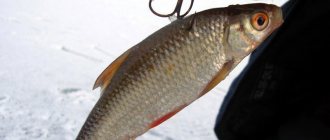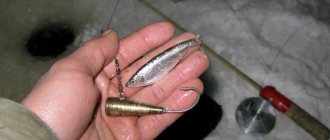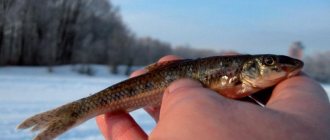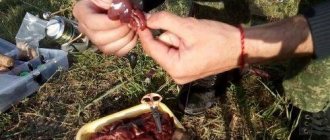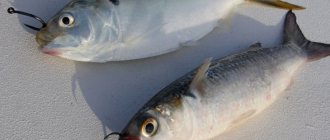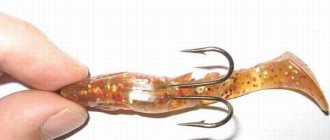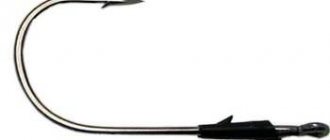Where are catfish found?
The predatory fish lives in the Bug River and many other bodies of water in Russia. It prefers deep holes in river beds, piles of stumps and rhizomes, and places with slow, calm currents. A fairly large pit can house several catfish at once, which leave their shelter only for hunting and spawning. Therefore, when catching catfish on a donk, you should look for it in certain places:
- A place with a reverse current or a small hole washed out by the current. The fish chooses such a passage to hunt near the shore or in a tributary, where the prey should be caught.
- Adults and juveniles live in water holes away from the bridge. The donka is thrown approximately 50 meters.
- Behind the support of the bridges on the reservoir, the current creates holes in which predators live. However, it is difficult to catch them in these places, since catfish often run away under the bridge.
- Holes near overgrown river plants are a favorite place for fish, which hide here in sandy or muddy soil.
- Catfish can find a place to stay under a pier, boat, or pier. Sometimes they can be found under floating grass, which the fish uses as a sun shade. The predator can also live in the muddy bottom under dams.
Knowing all the favorite places of catfish, before casting a bottom fishing rod, you should first study and examine the bottom of the reservoir.
The predator hunts both in the upper layers of reservoirs and in the water column for small and medium-sized fish. Its prey most often is ruffe, loach, perch, minnow, and gudgeon. Large individuals prey on roach and white fish. During the hunt, catfish make slurping sounds and leave water breakers behind them. This behavior is a feature of only this type of fish.
As soon as the water temperature in the river drops, predators migrate downstream and choose deep holes at the mouth of rivers for wintering. There they fall into a state of torpor until spring. That is why catfish hunting is seasonal.
Float tackle for catfish
Such a giant as catfish can also be caught using float tackle. But the equipment needs stronger!
Float equipment for catfish
The choice of rod, reel, fishing line, leaders and hooks is identical to the previous equipment. Let's move straight to the float.
For catfish equipment, both a fixed and a sliding float are suitable. A fixed float is used at depths of up to two meters, and its weight must be at least 10g. The sliding one is more suitable for depths of three meters or more.
Fishing method
First you need to choose a suitable place for fishing, it should be near the pits or the fishpond. The most successful fishing for catfish on a float is usually at dusk; a bite is also possible in the middle of the night. You need to use a variety of bait, then the chances of catching catfish will increase significantly. Frogs, crawling worms, giblets and mole crickets are ideal.
The cast is made so that the bait lies just near the hole, a little upstream. It’s better not to take your eyes off the float, and if the line is too tight, it’s better to hook it right away, otherwise you may be left not only without equipment, but also without a rod.
Features of catching predators by season
Catching catfish on a donk from the shore depends on the lifestyle of the predator in a particular season:
We also recommend reading:
Gardner loop for a feeder: how to tie Feeder fishing for crucian carp Installation of gear Do-it-yourself bottom gear, production and use How to choose the right feeder for carp fishing
- At the beginning of April, the fish come out of hibernation and begin hunting. At this time, a donk is used for catfish and the first bite appears.
- In the second half of April, the predator is caught using a spinning rod.
- In the first half of May, the fish leave for spawning and hunting for it stops.
- In the second half of May, the predator begins to be active and you can start catching it with bottom fishing rods.
- All summer there is high activity of catfish, so it is during the summer months that fishermen are actively engaged in catching catfish from the shore.
- In the second half of September, the bite decreases as the predator begins to migrate.
- From November to March, the fish hibernate and fishing stops.
Snack on catfish
The main feature of catfish equipment is high-quality components, such as swivels and fasteners; their breaking strength should not be less than 50 kg.
Article on the topic: Fishing on medium rivers
Snack equipment
You can easily make the equipment for the throw yourself; for this, a reel is made from a medium-sized plank. And then up to sixty meters of fishing line, with a diameter of 0.6 mm, is wound around it. A blind or sliding sinker weighing at least 100g is attached to the end of the fishing line. A little above the sinker, through a swivel, attach a leash up to 70 cm long, and then a hook, at least 8/0, and preferably with serifs.
Lure
Catching catfish using bait involves feeding it at the very beginning of fishing. Pieces of meat, liver, animal entrails, and singed poultry carcass would work ideally here.
Preparing gear
To catch your trophy, you need to carefully consider the choice of gear for catching catfish on the river. Before fishing you need to prepare and check:
- A powerful rod 2.5–3 meters long.
- Convenient, durable, inertia-free carp reel.
- Dense monofilament line with a diameter of up to 11 mm for small fish and nylon thread or braided double fishing line for catching large prey. The length of the fishing line must be at least 150 meters.
- A leash no more than 0.5 meters long and with a diameter 1.15 mm thinner than the main line.
- A load weighing from 50 to 120 grams. The choice of weight depends on the expected catch and the current on the river.
- The hook (double or tee) can be from No. 10 to No. 40.
After checking the gear, you can assemble the bottom equipment for catching a trophy with your own hands.
Donka for catching catfish
You can catch a predator using bottom tackle with a float, which is designed to lift live bait from the bottom. This gear is assembled as follows:
- a sinker weighing 150 grams is attached to the end of the fishing line;
- after 15 cm from the sinker, first one double hook is tied, and after a short distance - a second one;
- after another 10 cm, one of the ends of a powerful carabiner is attached to the fishing line, which must be tied well to the main fishing line.
To create a leash for a catfish you will need:
- thread a thread or double fishing line through a load weighing 150–170 grams;
- place a small sliding bead under the load;
- tie the end of the fishing line to the carabiner with a fishing knot;
- attach a high-quality forged hook to the fishing line, the size of which depends on the weight of the intended catch;
- After 15–20 cm from the hook to the fishing line, a carabiner is attached using a loop.
Zywiec
The main factor on which the optimal choice depends is size. You need to at least have an approximate idea of what size fish can be found at the fishing site. As a rule, the fish that can be pulled out is 9 times larger than the bait fish. According to calculations, for a fish weighing 500 grams, a predator weighing approximately 4.5 kilograms will bite. When the fishing site is inhabited by particularly large fish, the minimum weight of the bait should be 1 kilogram. Of course, a fish of this weight cannot be called live bait, but it is with it that you can catch a real giant.
Read: Catching catfish in July
In addition, it is worth taking into account the fact that the giant practically does not bite fish bought in a store. It is advisable to use live bait caught at the fishing site. The fish has an excellent sense of smell, for this reason the fish grabs live bait with a familiar smell. You can use almost any fish for live bait. The most important thing is that it lives in a given body of water. It’s all too early for the fish to know what kind of body the bait has. With its mouth, a predator can swallow fish whose size is 2 times smaller than its body.
When fishing for this fish, it will not be possible to place too large live bait. For a beginner, it is advisable to use small fish. Over time, the size of the fish gradually increases. When using large-sized live bait, you will have to wait. This is the main difference between small fish - they bite much more often.
The best baits for donkey
For catfish, you should choose a tasty bait, which should be varied. Experienced fishermen use the following types of bait for successful hunting :
- artificial baits;
- chicken liver;
- bird carcasses;
- offal from small birds;
- whole live leeches;
- mussel shells;
- green frogs;
- mole cricket;
- fish fry;
- live crayfish on a triple hook or just crayfish meat;
- ordinary dung worms.
Mainly young individuals bite on fry, worms and shells. This bait is attached to small hooks. Adult large catfish bite on frogs and leeches or on small squints and ides. Bottom dwellers like bait in the form of stewed bird offal. Crayfish and their meat are considered a delicacy for predators. For giants weighing about 50 kg, bait - a wooden barrel - works well. Among the artificial baits you can choose wobblers and spinners.
Live bait for catfish
Live bait for catfish must be selected based on the size of the predator you plan to catch. In most cases, the caught catfish is 8 times larger than the live bait used. This means that using live bait weighing 0.5 kg, a predator weighing about 4 kg will be caught. In this case, if larger specimens live in the reservoir, the live bait should be about 3 kg.
It is very important to catch live bait, and not buy it at the market. Plus, it’s worth doing this in the same body of water, since catfish have a good sense of smell.
Read: Successful catfishing - the most important secrets
Any type of fish can be used for live bait. The main thing is that it was caught in the same lake.
If you plan to catch catfish for the first time, then first you need to use live bait weighing half a kilo. It is worth increasing the size of live bait gradually. Only patient fishermen will be able to catch a real trophy, as this will require very careful attention.
How to catch catfish on a donk?
The fishing location is studied in advance. It is necessary to inspect the shore, find out where the holes are in the reservoir and what other fishermen feed the predators with. On the day of fishing, donks are installed. It is recommended to do this according to the following scheme:
- one bottom - at the gentle exit from the depression;
- two - in the lower parts of the pit;
- one is on the pit itself.
If fishing is done in the summer, then in the evening a fire is lit and bottom gear is installed. It is necessary to check that they are well fixed. After this, the reels’ brake mechanisms are adjusted and light or sound bite alarms are installed.
As soon as the bite occurs , the prey should be fished out, applying remarkable restraint. You should not wrap the fishing line around your hand, otherwise the fisherman may be thrown into the water with a jerk.
Features of fishing from a boat
Fishing from a boat has its advantages and disadvantages. The advantage is that the fisherman is located near the fishing spot, as a result of which the bait is delivered exactly to the desired point. For such hunting, you can use a thinner and not very long fishing line.
The downside of fishing from a boat is the difficulty of landing trophy fish. The giant can pull hard, causing the fisherman to end up overboard. Catching catfish alone on a rubber boat is risky.
Fishing with a worm
it is better to catch it for the first time . To do this, use a large hook with a long shank, onto which a bunch of worms or crawlers is strung. You won’t be able to catch trophy fish with them, but you will be able to practice catching a predator.
To attract fish, you can mount a feeder and attach two hooks to the bottom. A mixture of chopped worms and soil should be placed in the feeder as bait. In addition to catfish, perch, bream, and ide can bite on worms.
How to put live bait on a hook
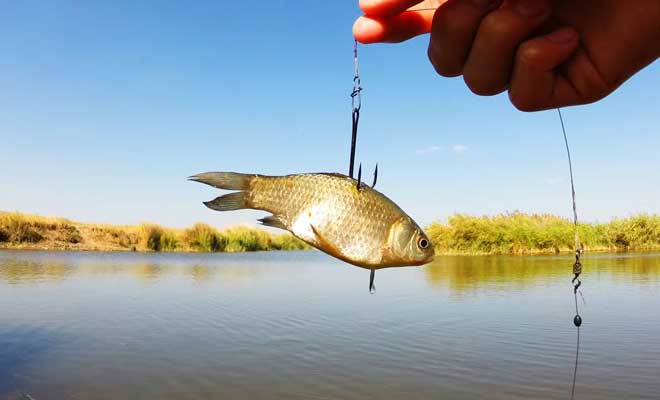
How to hook fish will directly depend on the current and its presence. If the river is calm or there are slight fluctuations, then it is necessary to hook live bait under the dorsal fin. The hook or tee is threaded in such a way as not to touch the ridge. Otherwise, the instance will lose activity, and this is not very good. Sometimes the catfish bites on this, but it depends on your luck.
If fishing, on the contrary, is carried out in the current, then the decoy fish is hooked by the lip so that all movements are natural. The baitfish will be upstream, actively attracting the predator.
Some fishermen resort to a different method. They pass a leash through the gill opening, which is then brought out through the mouth, and then fastened to the tee. The latter will be peeking out of the mouth. The presented method makes it possible to keep live fish for as long as possible, because in this case the live bait receives almost no injuries.
If you want to use another non-traumatic method, then you need to use an elastic band, which is used to tighten the bills. To do this, you will need to wrap the rubber band under the fish’s tail several times, and hide the tee under the rubber band. Again, in this position the fish is not injured, at the same time its movements resemble the behavior of a wounded river inhabitant, to which the catfish will definitely pay attention.
Read more about the different methods of hooking live bait and why each individual method is good.
There are fishermen who thread the hook through the caudal fins. This method is also considered gentle in the sense that none of the organs is affected, therefore, the fish can “sit” on the hook for quite a long time and lure out the predator.
Catfish habitats
Catching catfish will be successful only if you choose the right place to supply live bait. This predator lives mainly in pits. The type of preferred recesses of catfish depends on the species of individual. In a deep hole you can often find several large individuals. It is possible to determine the location of such a hole using an echo sounder. If you have time, you can also watch catfish in the evening. In those places where it splashes its tail, there are often holes.
- Related Posts
- Features of catfishing, tips and secrets
- Autumn. Catfish bait
- Som. Spoon fishing tactics
- Catching catfish with live bait. Important nuances for successful fishing
